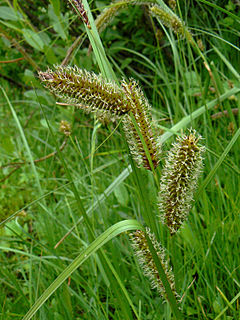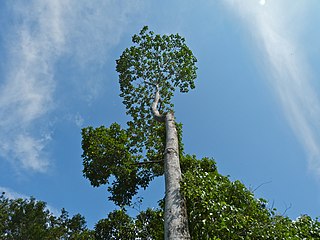
Dioscorea communis or Tamus communis is a species of flowering plant in the yam family Dioscoreaceae and is commonly known as black bryony, lady's-seal or black bindweed.

Mangifera caesia is a species of flowering plant in the cashew family, Anacardiaceae. Common names include jack or white mango. It belongs to the same genus as the mango and is widely cultivated in areas of Indonesia, Malaysia, Singapore, Brunei, Papua New Guinea and the Philippines.

Nepenthes campanulata, the bell-shaped pitcher-plant, is a tropical pitcher plant native to Borneo. It has also been reported from Palawan, the Philippines, though further field work is needed to confirm this identification.

Helianthus maximiliani is a North American species of sunflower known by the common name Maximilian sunflower.

Carex aquatilis is a species of sedge known as water sedge and leafy tussock sedge. It has a circumboreal distribution, occurring throughout the northern reaches of the Northern Hemisphere. It grows in many types of mountainous and arctic habitat, including temperate coniferous forest, alpine meadows, tundra, and wetlands.

Scorodocarpus is a monotypic genus of plant in the family Olacaceae. It has also been classified in the family Strombosiaceae. The generic name is from the Greek meaning "garlic fruit", referring to the smell of the fruit. As of June 2014 The Plant List recognises the single species Scorodocarpus borneensis. The specific epithet borneensis is from the Latin meaning "of Borneo".

Sonneratia alba is a mangrove tree in the family Lythraceae. The specific epithet alba is from the Latin meaning "white", referring to the flowers.
Durio crassipes, also known as durian hutan, is a species of flowering plant in the mallow family that is endemic to Borneo.
Bouea oppositifolia, also known as plum mango, kundang, kundangan or remenia, is a species of flowering plant, a fruit tree in the mango family, that is native to Indochina and Southeast Asia.

Molineria latifolia, also known as tambaka, lamba and lemba babi, is a species of flowering plant, a stemless perennial herb in the Hypoxidaceae family, that is native to Southeast Asia and produces edible fruits.

Artocarpus tamaran, also known as elephant jack in English, tarap tempunan in Malay, and more locally as timbangan, tamaran, entawa or wi yang, is a species of flowering plant, a fruit tree in the fig family, that is native to Southeast Asia.
Ficus uncinata, also known as earth fig in English and as ara entimau in Iban, is a species of flowering plant, a fruit tree in the fig family, that is native to Southeast Asia.
Sarcotheca diversifolia, also known as pupoi or belimbing bulat in Malay and more locally as tabarus, piang or belimbing hutan, is a species of flowering plant, a fruit tree in the wood sorrel family, that is native to Southeast Asia.
Heliciopsis artocarpoides, also known as kurunggu or putat, is a species of flowering plant, a tropical forest fruit-tree in the macadamia family, that is native to Southeast Asia.

Rubus fraxinifolius, also known as mountain raspberry in English or ragimot, is a species of flowering plant, a fruiting shrub in the raspberry family, that is native to Asia.

Lepisanthes alata, also called the Johore tree, blimbing cina, ceri or engkili, is a species of flowering plant, a tropical forest fruit-tree in the lychee family, that is native to Southeast Asia.
Lepisanthes multijuga is a species of flowering plant, a tropical forest fruit-tree in the lychee family, that is native to Southeast Asia.
Nephelium maingayi, also known as serait in Malay, mujau in Iban, and buah sungkit in Sabah and Brunei, is a species of flowering plant, a tropical forest fruit-tree in the rambutan family, that is native to Southeast Asia.
Nephelium papillatum is a species of flowering plant, a tropical forest fruit-tree in the rambutan family, that is endemic to Borneo.
Alpinia nieuwenhuizii, also known as lalemas or terebak, is a species of flowering plant, a perennial tropical forest herb in the ginger family, that is endemic to Borneo.










